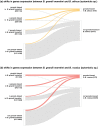Gene transcriptional profiles in gonads of Bacillus taxa (Phasmida) with different cytological mechanisms of automictic parthenogenesis
- PMID: 36435814
- PMCID: PMC9701443
- DOI: 10.1186/s40851-022-00197-z
Gene transcriptional profiles in gonads of Bacillus taxa (Phasmida) with different cytological mechanisms of automictic parthenogenesis
Abstract
The evolution of automixis - i.e., meiotic parthenogenesis - requires several features, including ploidy restoration after meiosis and maintenance of fertility. Characterizing the relative contribution of novel versus pre-existing genes and the similarities in their expression and sequence evolution is fundamental to understand the evolution of reproductive novelties. Here we identify gonads-biased genes in two Bacillus automictic stick-insects and compare their expression profile and sequence evolution with a bisexual congeneric species. The two parthenogens restore ploidy through different cytological mechanisms: in Bacillus atticus, nuclei derived from the first meiotic division fuse to restore a diploid egg nucleus, while in Bacillus rossius, diploidization occurs in some cells of the haploid blastula through anaphase restitution. Parthenogens' gonads transcriptional program is found to be largely assembled from genes that were already present before the establishment of automixis. The three species transcriptional profiles largely reflect their phyletic relationships, yet we identify a shared core of genes with gonad-biased patterns of expression in parthenogens which are either male gonads-biased in the sexual species or are not differentially expressed there. At the sequence level, just a handful of gonads-biased genes were inferred to have undergone instances of positive selection exclusively in the parthenogen species. This work is the first to explore the molecular underpinnings of automixis in a comparative framework: it delineates how reproductive novelties can be sustained by genes whose origin precedes the establishment of the novelty itself and shows that different meiotic mechanisms of reproduction can be associated with a shared molecular ground plan.
Keywords: Gene expression; Parthenogenesis; Phylostratigraphy; RNA-seq; dN/dS.
© 2022. The Author(s).
Conflict of interest statement
The authors declare that they have no competing interests.
Figures






Similar articles
-
Parthenogenetic Stick Insects Exhibit Signatures of Preservation in the Molecular Architecture of Male Reproduction.Genome Biol Evol. 2024 May 2;16(5):evae073. doi: 10.1093/gbe/evae073. Genome Biol Evol. 2024. PMID: 38573594 Free PMC article.
-
Multiple direct transitions from sexual reproduction to apomictic parthenogenesis in Timema stick insects.Evolution. 2009 Jan;63(1):84-103. doi: 10.1111/j.1558-5646.2008.00524.x. Epub 2008 Sep 18. Evolution. 2009. PMID: 18803687
-
The IGS-ETS in Bacillus (Insecta Phasmida): molecular characterization and the relevance of sex in ribosomal DNA evolution.BMC Evol Biol. 2008 Oct 9;8:278. doi: 10.1186/1471-2148-8-278. BMC Evol Biol. 2008. PMID: 18844990 Free PMC article.
-
Meiosis and its deviations in polyploid animals.Cytogenet Genome Res. 2013;140(2-4):185-203. doi: 10.1159/000351731. Epub 2013 Jun 18. Cytogenet Genome Res. 2013. PMID: 23796636 Review.
-
Genotypic characteristics of cyclic parthenogens and their obligately asexual derivatives.Experientia Suppl. 1987;55:175-95. doi: 10.1007/978-3-0348-6273-8_8. Experientia Suppl. 1987. PMID: 2961596 Review.
Cited by
-
Parthenogenetic Stick Insects Exhibit Signatures of Preservation in the Molecular Architecture of Male Reproduction.Genome Biol Evol. 2024 May 2;16(5):evae073. doi: 10.1093/gbe/evae073. Genome Biol Evol. 2024. PMID: 38573594 Free PMC article.
References
-
- Mogie M. Automixis: its distribution and status. Biol J Linn Soc. 1986;28:321–329. doi: 10.1111/j.1095-8312.1986.tb01761.x. - DOI
Grants and funding
LinkOut - more resources
Full Text Sources

